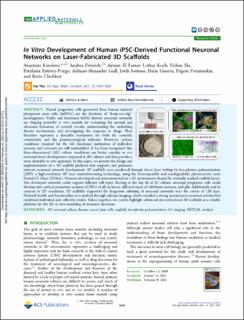| dc.contributor.author | Koroleva, Anastasia | |
| dc.contributor.author | Deiwick, Andrea | |
| dc.contributor.author | El-Tamer, Ayman | |
| dc.contributor.author | Koch, Lothar | |
| dc.contributor.author | Shi, Yichen | |
| dc.contributor.author | Estévez-Priego, Estefanía | |
| dc.contributor.author | Ludl, Adriaan-Alexander | |
| dc.contributor.author | Soriano, Jordi | |
| dc.contributor.author | Guseva, Daria | |
| dc.contributor.author | Ponimaskin, Evgeni | |
| dc.contributor.author | Chichkov, Boris | |
| dc.date.accessioned | 2022-03-14T07:56:04Z | |
| dc.date.available | 2022-03-14T07:56:04Z | |
| dc.date.created | 2022-01-18T14:52:54Z | |
| dc.date.issued | 2021 | |
| dc.identifier.issn | 1944-8244 | |
| dc.identifier.uri | https://hdl.handle.net/11250/2984936 | |
| dc.description.abstract | Neural progenitor cells generated from human induced pluripotent stem cells (hiPSCs) are the forefront of ″brain-on-chip″ investigations. Viable and functional hiPSC-derived neuronal networks are shaping powerful in vitro models for evaluating the normal and abnormal formation of cortical circuits, understanding the underlying disease mechanisms, and investigating the response to drugs. They therefore represent a desirable instrument for both the scientific community and the pharmacological industry. However, culture conditions required for the full functional maturation of individual neurons and networks are still unidentified. It has been recognized that three-dimensional (3D) culture conditions can better emulate in vivo neuronal tissue development compared to 2D cultures and thus provide a more desirable in vitro approach. In this paper, we present the design and implementation of a 3D scaffold platform that supports and promotes intricate neuronal network development. 3D scaffolds were produced through direct laser writing by two-photon polymerization (2PP), a high-resolution 3D laser microstructuring technology, using the biocompatible and nondegradable photoreactive resin Dental LT Clear (DClear). Neurons developed and interconnected on a 3D environment shaped by vertically stacked scaffold layers. The developed networks could support different cell types. Starting at the day 50 of 3D culture, neuronal progenitor cells could develop into cortical projection neurons (CNPs) of all six layers, different types of inhibitory neurons, and glia. Additionally and in contrast to 2D conditions, 3D scaffolds supported the long-term culturing of neuronal networks over the course of 120 days. Network health and functionality were probed through calcium imaging, which revealed a strong spontaneous neuronal activity that combined individual and collective events. Taken together, our results highlight advanced microstructured 3D scaffolds as a reliable platform for the 3D in vitro modeling of neuronal functions. | en_US |
| dc.language.iso | eng | en_US |
| dc.publisher | American Chemical Society | en_US |
| dc.rights | Attribution-NonCommercial-NoDerivatives 4.0 Internasjonal | * |
| dc.rights.uri | http://creativecommons.org/licenses/by-nc-nd/4.0/deed.no | * |
| dc.title | In Vitro Development of Human iPSC-Derived Functional Neuronal Networks on Laser-Fabricated 3D Scaffolds | en_US |
| dc.type | Journal article | en_US |
| dc.type | Peer reviewed | en_US |
| dc.description.version | publishedVersion | en_US |
| dc.rights.holder | Copyright 2021 The Authors | en_US |
| cristin.ispublished | true | |
| cristin.fulltext | original | |
| cristin.qualitycode | 1 | |
| dc.identifier.doi | 10.1021/acsami.0c16616 | |
| dc.identifier.cristin | 1983768 | |
| dc.source.journal | ACS Applied Materials & Interfaces | en_US |
| dc.source.pagenumber | 7839-7853 | en_US |
| dc.identifier.citation | ACS Applied Materials & Interfaces. 2021, 13 (7), 7839-7853. | en_US |
| dc.source.volume | 13 | en_US |
| dc.source.issue | 7 | en_US |

